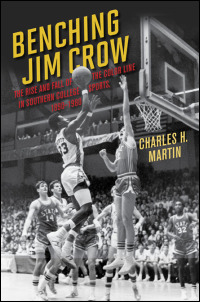 ‘Tis the season, for Christmas presents, holiday cheer, New Year’s resolutions—and college football’s never-ending parade of bowl games (35 in all this year)!
‘Tis the season, for Christmas presents, holiday cheer, New Year’s resolutions—and college football’s never-ending parade of bowl games (35 in all this year)!
When I began the research for my book, Benching Jim Crow: The Rise and Fall of the Color Line in Southern College Sports, 1890-1980, I hadn’t really thought about the role that bowl games had played in maintaining racial segregation in athletics. As I perused old newspaper clippings, though, I discovered that almost all of the early bowl games had maintained a rigid color line for at least a decade or more after their founding.
During the mid-1930s, local boosters created the Sugar, Orange, Sun, and Cotton Bowl games in order to attract national publicity and promote tourism. But sports promoters in New Orleans, Miami, El Paso, and Dallas shared the racial biases of their fellow white citizens, and so from the start they imposed a ban on African American players. Only California’s Rose Bowl, which dates from 1916, was the exception to this rule.
Since most northern teams did not include any black players at the time (yes, I know this is hard to believe), such exclusion was not a major source of conflict until after World War II, when African Americans became more common on these squads. Then, in order to avoid losing the most appealing northern teams, first the Cotton Bowl and then the Sun Bowl and the Orange Bowl dropped their racial prohibitions.
The Sugar Bowl held out against the trend until January, 1956, when Georgia Tech defeated an integrated Pittsburgh squad. Segregationists in the Louisiana legislature promptly responded by adopting a new law banning interracial competition in sports. Not until 1965, after the federal courts had struck down all sections of the Louisiana law, was the Sugar Bowl finally able to host its second integrated contest.
It seems strange to modern sensibilities that bowl games, which today feature numerous African American stars, could once have been an all-white affair. Yet the early history of such contests reveals how deeply entrenched racial exclusion and white privilege were in southern and American society before the 1960s, even on the supposedly “level playing field” of college football.
*****
Charles H. Martin is an associate professor of history at the University of Texas at El Paso and the author of Benching Jim Crow: The Rise and Fall of the Color Line in Southern College Sports, 1890-1980.
